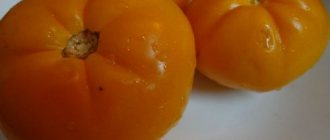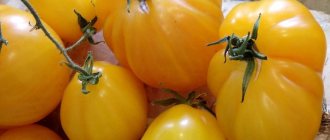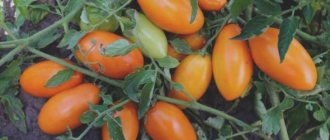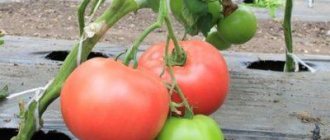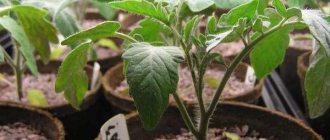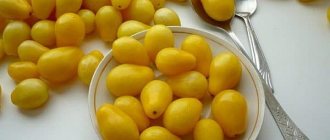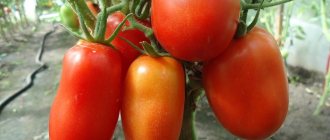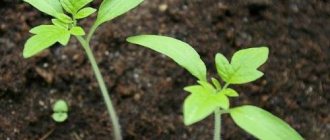The Golden Cockerel tomato is the result of developments of Russian selection. The creators made it resistant to diseases and parasites, while maintaining a great taste and giving it an interesting appearance.
| Height | Landing location | Ripening time | Fruit color | Fruit size | Origin | Fruit shape |
| Tall | Greenhouse, Open ground | Mid-season | Yellow | Average | Variety | With spout |
Features of the plant
The bush is of indeterminate (tall) type, its height reaches up to 2 m, most often 1.6-1.8 m. The stems are powerful, the leaves have the usual shape and size, the plant needs staking and pinching, which should be carried out throughout the entire growing season period. It develops faster in warm climates or in greenhouse conditions. It can be grown in one stem, but the best results are obtained when forming 2-3 or even 4 stems. The growing season of the Golden Cockerel tomato ranges from 110 to 125 days. This is the period of time from complete germination of seeds to the beginning of fruit ripening.
Description and characteristics of the Golden Cockerel tomato variety, reviews, photos
Mid-season, cluster-bearing, productive tomato variety for greenhouses and open ground.
Bush of indeterminate type, 1.6-1.8 meters high, leaf of ordinary type. Requires tying to the support and pinning. The best results were obtained when forming a plant with 2 or 3 stems.
Read also: How to take Eleutherococcus tincture for adults
Basic qualities of fruits
The fruits are elongated with a sharp nose, dense, bright yellow in color at maturity, weighing 60-80 grams, juicy, with good tomato taste. These tomatoes are ideal for whole canning, but are also good for fresh consumption.
Color, size, taste of fruits
The fruits have a bright yellow color, a pronounced “spindle-shaped” (elongated) shape, they are very dense, weighing 85-120 g. In one bunch, under favorable conditions, from 5 to 10 tomatoes are formed. The taste is high, the taste is pleasant, rich tomato, slightly sweet. The fruits are fleshy and have few seeds, making them very pleasant to eat.
The “Golden Cockerel” variety has a universal purpose; it can be consumed in its pure form, as part of gourmet salads, and can also be preserved in various ways. The fruits are stored for a long time in a cool, dark place and do not lose their taste over time. The yield of the “Golden Cockerel” ranges from 3 to 7 kg per bush (subject to the requirements of agricultural technology). Maximum yield can only be achieved in greenhouse conditions, especially in the northern regions.
Characteristics and description of the variety with photos
The main positive aspects of this tomato are good yield, unusual shape and color of ripe fruits, good taste and commercial qualities.
The Golden Cockerel variety is medium-late in terms of ripening - about 4 months pass from the moment of sowing the seed material to the harvesting of the first ripe fruits. Fruiting of these tomatoes is long, clusters are formed in the axils of the leaves, on each of which up to 6-8 ovaries are formed.
Golden Cockerel tomato bushes belong to the indeterminate type, the shoots are erect, tall, and can reach 1.7-2.0 m in height. The stems are strong, powerful, dark emerald in color.
During the period of fruit ripening, it is necessary to tie the shoots to supports; the bushes require mandatory pinching. The best yield can be achieved when forming a bush of 2-3 shoots.
The foliage is a rich dark emerald color, regular in shape, characteristic of tomatoes.
The shape of ripe fruits is spindle-shaped, rich yellow in color. The pulp is yellow, dense, fleshy, sweetish with the sourness characteristic of this vegetable. There are few seed chambers, and there are also few seeds. The skin is smooth and dense. The presentation and taste of ripe tomatoes are excellent.
The harvested crop can easily be transported over long distances without losing its presentation or taste.
Ripe fruits are universally used, they can be eaten fresh, made into salads, salted in barrels, pickled, prepared for other preparations: lecho, juice, etc. The harvested crop has a high shelf life in a cool, dark place.
The Golden Cockerel tomato has good resistance to most diseases characteristic of vegetable plants of the Solanaceae family.
Features of cultivation
Sowing of seeds is carried out 60-65 days before planting seedlings in open ground for permanent residence (ideal planting time is March). Purchased seeds do not need to be further processed, but with seeds extracted from the fruit yourself, you will have to do a little work before sowing:
- To check the quality of the seeds, they are soaked in a weak saline solution (a teaspoon per glass of water). Those that pop up are rejected.
- Immediately before planting, the seeds need to be disinfected, since most diseases “live” on their surface. For disinfection, planting material is kept in a 1% solution of potassium permanganate for about 20 minutes. You can also treat it in a 2-3% peroxide solution heated to 45 degrees.
- To improve varietal qualities and germination, seeds must be soaked in a nutrient solution of Epin or Immunocytophyte.
After all the above procedures, you can sow with or without preliminary germination. Germination speeds up the process of seedling germination, and also allows you to reject planting material at the initial stages of cultivation. This procedure is carried out using a damp cloth or cotton cloth: the seeds are laid out on the cloth, covered with film and kept in a warm place (20-25 degrees) for several days until the sprouts emerge.
Already sprouted or dry store-bought seeds should be planted on peat soil at a distance of 1 cm from each other. A centimeter layer of the lightest peat is poured on top, then watering is carried out through a sprayer or strainer, but not with a direct, high-pressure stream, otherwise the seeds will float. The container with seedlings is covered with film, and it is recommended to place it in a well-lit place with an elevated temperature of up to 25 degrees. After the sprouts appear, the film is gradually removed, the seedlings are hardened and accustomed to the dry air in the living room.
In the phase of 1-3 true leaves, seedlings must be planted in separate pots or plastic glasses, slightly buried. To prevent pulling, an additional 12-hour backlight can be provided. In the phase of 5-6 true leaves, plants can be planted in a greenhouse or open soil. When planting seedlings in a permanent place per 1 sq. m. area you need to place no more than 4 plants. If the soil moisture is high, then it is recommended to loosen the tomatoes more often to prevent rotting.
As the tomatoes grow, they are tied to high supports and, if growth does not stop, the crown is pinched. To form two or more stems, it is necessary to regularly remove all incorrectly growing stepsons. It is better to do this in the morning so that the wounds have time to dry, and to prevent diseases, the places where the stepchildren are separated can be treated with charcoal or brilliant green.
Watering is carried out regularly after the top layer of soil has dried to a depth of 4-5 cm. To simplify this procedure, you can install a homemade drip system or an automatic sprayer. It is recommended to water with cool water with a temperature of no more than 16 degrees.
Planting and care
Between planting the seeds and transferring the bushes to the garden bed, 60-65 days should pass. If you overstay the seedlings, the yield will be worse. The seeds are sown in nutritious soil containing, in addition to plain soil, also peat, river sand and a little fertilizer. Germinate in warmth. When the bushes produce 2-3 true leaves, they are picked.
Before transferring to a permanent location, seedlings need to be hardened off for a week.
Plant 3 plants per square meter. Stepchildren are cut at a distance of 1 cm from the stem. Water with warm water, tie up, loosen the soil.
Rules for gartering a bush:
Gartering, like other procedures, must be carried out with great care to avoid damage. This is carried out until the plant stops its growth. The easiest way is to tie it to a tensioned wire.
- Several sticks are installed along the bed, between which we stretch the wire. Since the plant is tall, at least 3 levels are required for tying.
- You need to tie it with ribbons or thick threads. If the thread is thin, it will simply cut the plant.
- We tie the stem as it grows. 1 garter approximately 25 centimeters from the ground. The second one is possible already at the level of 1 meter. It is very important to tie not only the stem but also the brushes so that they do not break under the weight of the fruit. We tie the brushes in the middle and move them to the sides. This way you should get a “tomato wall”.
As for the formation of bushes.
- A tomato bush is formed into 2 stems (less often 3 or more).
- Stepchildren that reach 4-5 centimeters break off at a distance of 1 centimeter from the stem.
- It is very important to perform pinching in the morning, in warm and calm weather.
- Formation is performed on a side shoot, and the main one is pinched.
- After processing each bush, rinse your hands (always wearing gloves) in a weak solution of potassium permanganate to avoid the development of diseases.
Disease resistance
There is an opinion that yellow-fruited varieties, including “Golden Cockerel,” are more resistant to diseases, especially late blight. Fortunately, this is absolutely true; moreover, in addition to late blight, the variety described above has resistance to:
- fusarium;
- tobacco mosaic;
- cladosporiosis.
The only serious threat to tall tomatoes is aphids, but this pest is very easy to combat: it is enough to periodically spray the bushes with Karbofos, Trichlorometaphos or similar insecticides. Among the folk remedies against aphids, soap solutions (household soaps), tobacco infusions, herbal decoctions of garlic, wormwood or hot pepper work well.
Diseases and dangerous insects
It is generally accepted that yellow-fruited tomatoes are more resistant to infections and viruses than varieties of standard flowers. This is true. The Golden Cockerel is not afraid:
- cladosporiosis;
- fusarium;
- tobacco mosaic
Of the pests, aphids are partial to the variety. The following drugs help control this insect: Karbofos, Trichlorometaphos and other insecticides. You can also use folk remedies, such as tobacco tincture, garlic infusion, laundry soap solution, infusion of wormwood or hot pepper.
Reviews
Irina: A wonderful variety, I really liked it as a greenhouse crop. My grandchildren love the bright yellow fruits and immediately run to them when they come to visit. The taste is excellent, the tomato is pleasant to eat just like that or in jars as part of canned salads.
Victor: I hunted for this variety for a long time, and last year my friends shared the seeds. There were problems with germination, out of 10 pcs. Only 3 sprouted, but the variety justified itself by bearing fruit, actually harvesting 5 kg of fruit from a bush in a greenhouse. I’ll leave it, I really liked the taste, so juicy, meaty, rich!
Pros and cons of the variety
According to reviews from vegetable growers, these tomatoes have the following positive qualities:
- the versatility of using the harvested crop;
- extended fruiting;
- high resistance to most diseases characteristic of tomato varieties;
- original shape and bright color of ripe fruits;
- relative unpretentiousness to growing conditions and further care.
But this vegetable crop also has disadvantages:
- the growing season is long;
- requires the formation of bushes, garter to supports;
- the need for stepsoning;
- the cost of seeds is high, and seed material is rarely available for sale.
Read also: Is it healthy to eat grapes with seeds?
